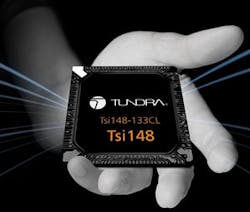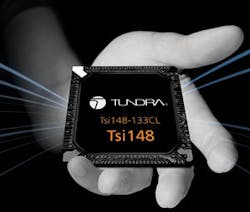Engineers at GE Fanuc Embedded Systems in Charlottesville, Va., needed an efficient interconnection to the VME backplane in the company’s new V7865 Intel Dual Core single-board computer (SBC). They chose the new Tsi148 PCI/X-to-VME interconnect bridge from Tundra Semiconductor Corp. in Ottawa.
The V7865, GE Fanuc Embedded Systems’ flagship Core 2 Duo VMEbus single-board computer, operates at processor speeds as fast as 2.16 GHz and is offered in ruggedized form for military and aerospace applications in harsh environments.
The Tundra Tsi148 ensures the V7865 complies with the ANSI/VITA 1.5-2003 specification, a VME standard also known as VME320 that uses a bus protocol called 2 Edge Synchronous Source Transfer (2eSST). Offering more than an eight times improvement over conventional VME32, 2eSST is capable of achieving sustained data transfer rates of as much as 320 Mbytes per second in a full chassis of as many as 21 cards.
Tundra’s Tsi148 enables increased bandwidth and high-performance distributed processing by connecting several processing cards through the VME backplane. The Tsi148 can operate in VME64, 2eVME (VME160), and 2eSST (VME320) modes, making it plug-and-play compatible with virtually any other VME card in the chassis.
“We see increasing customer demand for greater overall system performance while at the same time preserving VMEbus legacy,” notes David K. Pepper, senior architect and technologist at GE Fanuc Embedded Systems. “With Tundra’s Tsi148 2eSST-compliant interconnect, we can provide customers with a backward-compatible solution which preserves VME64 functionality and protects existing investment, while offering an overall computing system upgrade in capability, capacity, and performance to current VME systems.”
For more information, visit Tundra Semiconductor and GE Fanuc Embedded Systems online at www.tundra.com and www.gefanucembedded.com, respectively.




